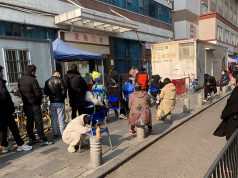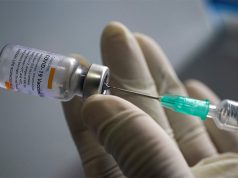
President Rodrigo Duterte made a misleading statement during his late-night national address that the novel coronavirus is airborne when health organizations repeatedly said it is otherwise.
MISLEADING: World Health Organization is firm that COVID-19 is generally transmitted through droplets/aerosols.
Read: https://t.co/iyAvAN5EFx https://t.co/FlrffQKSqv
— Fact-Check PH (@factcheckPH_AE) April 6, 2020
Another recorded national address of the president was aired at 10 pm on Monday. During which, Duterte said that the government is “inclined” to extend the enhanced community quarantine until April 30.
Cabinet Secretary Karlo Nograles, also the spokesperson of the COVID-19 inter-agency task force, only confirmed this extension on Tuesday to further contain the spread of the disease in the country. The community quarantine will expire by 11:59 p.m. of April 30.
The two-week extension will give more time for the government to flatten the curve, a term which refers to the goal of slowing down the spread to manageable terms by the health care system.
In the same speech, Duterte also claimed that the new pathogen is highly infectious because it is “in the air” while reiterating the importance of his directive to stay at home.
“Sa Amerika marami na ang patay. Italy, sa — ang France in one day or was it Italy? In one day, 500 ang patay. So it’s a deadly thing. That is why huwag kayong lumabas kasi alam mo ito it’s in the air,” he said.
He also repeated this when he was discussing the budget allocated for the government’s response efforts to the pandemic.
“Basta ang pang-kontra nito is stay home at huwag kang mahawaan because it’s in the air. Nandiyan sa hangin eh. Pero hindi ‘yan magtagal ‘yang mga virus sa labas, sa init. Pero nagko-contaminate ‘yan,” he said.
The president failed to contextualize that the viral particles are in the form of droplets that automatically land on surfaces after leaving the body.
This is not the first time Duterte made this claims. In nation address last Friday, Duterte also made the similar claim when he was prohibiting the public from conducting mass gatherings.
“If you keep on converging, kung saan-saan ka, then you spread the — it’s airborne ano, hangin eh. ‘Pag mag-ubo ka dito, ilang metro ‘yan dadalhin doon. Mikrobyo ‘yan eh. Part of the ha —part of the hangin. Kasali ng hangin ‘yan. ‘Pag doon isa, sabi niya, “Wala naman akong nilapitan na…” Wala nga,” the president said last April 3.
Airborne vs droplets
The World Health Organization explained that the difference between airborne and droplet transmissions depends on the size of droplets and the amount of time they last outside of the host body.
“Airborne transmission is different from droplet transmission as it refers to the presence of microbes within droplet nuclei, which are generally considered to be particles <5μm in diameter, can remain in the air for long periods of time and be transmitted to others over distances greater than 1 m,” the organization said in its website.
Both WHO and the Department of Health have also previously affirmed that COVID-19 can only be transmitted through droplets produced via coughs, sneezes or saliva discharge from the infected person within 1 meter of close contact.
“To protect yourself, keep at least 1 meter distance from others and disinfect surfaces that are touched frequently. Regularly clean your hands thoroughly and avoid touching your eyes, mouth and nose,” WHO said.
FACT: #COVID19 is NOT airborne.
The #coronavirus is mainly transmitted through droplets generated when an infected person coughs, sneezes or speaks.
To protect yourself:
-keep 1m distance from others
-disinfect surfaces frequently
-wash/rub your 👐
-avoid touching your 👀👃👄 pic.twitter.com/fpkcpHAJx7— World Health Organization (WHO) (@WHO) March 28, 2020
Airborne transmission may only be possible through medical procedures that generate aerosols. These procedures include administration of nebulized treatment, manual ventilation before intubation, and cardiopulmonary resuscitation.
Health Undersecretary Maria Rosario Vergeire earlier echoed this, saying that the viral particles that cause COVID-19 can only be considered airborne in confined hospital settings.
Last week, several posts claiming that the WHO confirmed that “COVID-19 is airborne” surfaced online.
Filipino vaccinologist based in Switzerland Melvin Sanicas wrote a long post debunking this claim.
In his post, Sanicas said “some publications show that COVID-19 virus can be detected in the air so news outlets have suggested that there has been ‘airborne transmission.'”
“These initial findings need to be interpreted carefully,” he added.
Sanicas cited that COVID-19’s airborne transmission “is possible in specific circumstances and settings in which procedures or support treatments that generate aerosols are performed.”
He cited medical procedures such as: endotracheal intubation, bronchoscopy, open suctioning, administration of nebulized treatment, manual ventilation before intubation, turning the patient to the prone position, disconnecting the patient from the ventilator, non-invasive positive-pressure ventilation, tracheostomy, and cardiopulmonary resuscitation.
As of April 7, the communicable disease infected a total of 3,764 patients and killed 177. Of the thousands of cases recorded, a total of 84 have already recovered.
There are already 10 certified laboratories nationwide that can conduct testing procedures with 2,000 tests daily.









